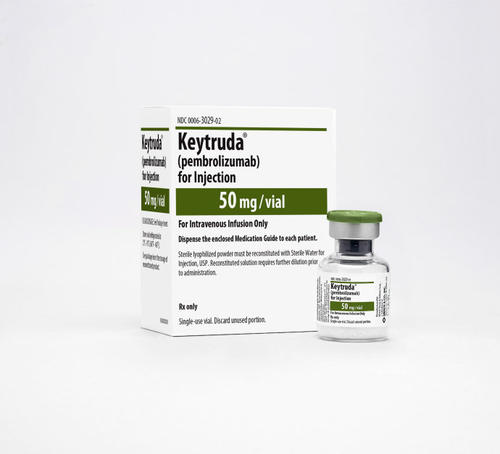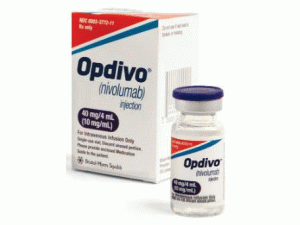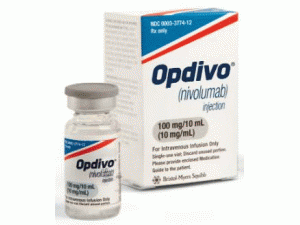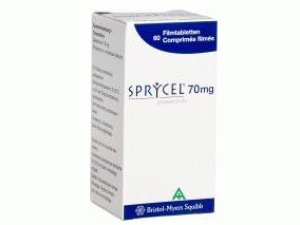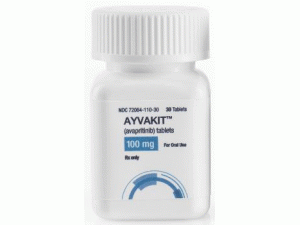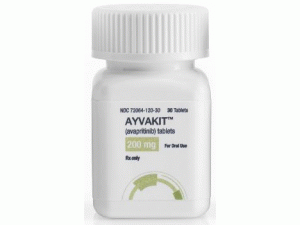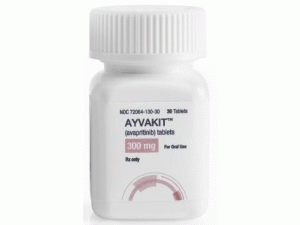阿卡替尼胶囊 acalabrutinib(Calquence Capsules 100mg)
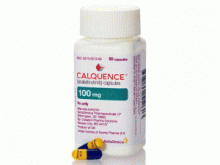 产地国家:美国
处 方 药:是
所属类别:100毫克/粒 60粒/瓶
包装规格:100毫克/粒 60粒/瓶
计价单位:瓶
生产厂家中文参考译名:阿斯利康制药
生产厂家英文名:AstraZeneca LP
原产地英文商品名:Calquence 100mg/Capsules 60Capsules/bottle
原产地英文药品名:acalabrutinib
中文参考商品译名:Calquence胶囊 100毫克/粒 60粒/瓶
中文参考药品译名:阿卡替尼
产地国家:美国
处 方 药:是
所属类别:100毫克/粒 60粒/瓶
包装规格:100毫克/粒 60粒/瓶
计价单位:瓶
生产厂家中文参考译名:阿斯利康制药
生产厂家英文名:AstraZeneca LP
原产地英文商品名:Calquence 100mg/Capsules 60Capsules/bottle
原产地英文药品名:acalabrutinib
中文参考商品译名:Calquence胶囊 100毫克/粒 60粒/瓶
中文参考药品译名:阿卡替尼
简介
近日,美国食品和药物管理局(FDA)批准新型抗癌药Calquence(acalabrutinib)口服胶囊为突破性药物资格(BTD),作为一种单药疗法治疗慢性淋巴细胞白血病(CLL)成人患者。CLL是成人最常见的白血病类型之一。Calquence于2017年10月获美国FDA加速批准,用于既往已接受至少一种疗法的复发性或难治性套细胞淋巴瘤(MCL)成人患者。目前,该药正被开发治疗CLL及其他血液系统恶性肿瘤。阿斯利康肿瘤研发执行副总裁Jos_Baselga表示:“这是我们在血液学方面取得的一个重要监管里程碑。该BTD认可了越来越多的证据支持Calquence作为一种高度选择性布鲁顿酪氨酸激酶(BTK)抑制剂为患者提供一种新的、具有良好安全性的、差异化的、无化疗治疗选择。” 批准日期:2017年10月31日 公司:AstraZeneca 美国初次批准:2017年 作用机理 Acalabrutinib是BTK的小分子抑制剂。Acalabrutinib及其活性代谢产物ACP-5862与BTK活性位点中的半胱氨酸残基形成共价键,从而导致BTK酶活性受到抑制。BTK是B细胞抗原受体(BCR)和细胞因子受体途径的信号传导分子。在B细胞中,BTK信号传导导致激活B细胞增殖,运输,趋化性和粘附所必需的途径。在非临床研究中,acalabrutinib在小鼠异种移植模型中抑制了BTK介导的下游信号蛋白CD86和CD69的活化,并抑制了恶性B细胞的增殖和肿瘤的生长。 适应症和用途 CALQUENCE是一种激酶抑制剂,适用于患有以下疾病的成年患者:已经接受过至少一种治疗的套细胞淋巴瘤(MCL)。根据总体响应率在加速批准下得到批准。对于该适应症的持续批准可能取决于验证试验中对临床益处的验证和描述。慢性淋巴细胞白血病(CLL)或小淋巴细胞淋巴瘤(SLL)。 剂量和给药 推荐剂量约为每12小时口服100 mg;用水或食物一起吞咽整只。建议患者不要打破,打开或咀嚼胶囊。通过中断治疗,减少剂量或中止治疗毒性。严重肝功能不全的患者应避免CALQUENCE。 剂量形式和强度 胶囊:100mg。 禁忌症:没有。 警告和注意事项 •严重和机会性感染:监测感染的体征和症状并及时治疗。•出血:监测出血并适当处理。•Cytopenias:定期监测全血细胞计数。•第二原发性恶性肿瘤:发生了其他恶性肿瘤,包括皮肤癌和其他实体瘤。建议患者使用防晒霜。•房颤和扑动:监测心律不齐的症状并进行管理。 不良反应 最常见的不良反应(发生率≥30%)为:贫血,中性粒细胞减少,上呼吸道感染,血小板减少,头痛,腹泻和骨骼肌疼痛。 药物相互作用 •CYP3A抑制剂:避免与强效CYP3A抑制剂共同给药。可能建议调整剂量。•CYP3A诱导剂:避免与强效CYP3A诱导剂共同给药。可能建议调整剂量。•胃酸还原剂:避免与质子泵抑制剂(PPI)并用。与H2受体拮抗剂和抗酸药交错给药。 在特定人群中的使用 怀孕:可能导致胎儿伤害和难产。哺乳期:建议不要母乳喂养。 包装供应/存储和处理方式 供应方式 每瓶60粒:100毫克,硬胶囊,黄体,蓝色,用黑色墨水标记“ ACA 100毫克” 100毫克:60粒/瓶 NDC:0310-0512-60 存储 储存在20°C-25°C(68°F-77°F); 允许的温度偏移范围是15°C-30°C(59°F-86°F)[请参阅USP控制的室温]。英文版说明书
CALQUENCE(acalabrutinib) Granted US Breakthrough Therapy Designation for Chronic Lymphocytic Leukemia US Food and Drug Administration(FDA) has granted Breakthrough Therapy Designation(BTD)for CALQUENCE(acalabrutinib)as a monotherapy treatment for adult patients with chronic lymphocytic leukemia(CLL), one of the most common types of leukemia in adults. IMPORTANT SAFETY INFORMATION ABOUT CALQUENCE(acalabrutinib) HemorrhageSerious hemorrhagic events, including fatal events, have occurred in the combined safety database of 612 patients with hematologic malignancies treated with CALQUENCE monotherapy.Grade 3 or higher bleeding events, including gastrointestinal, intracranial, and epistaxis, have been reported in 2% of patients. Overall, bleeding events, including bruising and petechiae of any grade, occurred in approximately 50% of patients with hematological malignancies. The mechanism for the bleeding events is not well understood. CALQUENCE may further increase the risk of hemorrhage in patients receiving antiplatelet or anticoagulant therapies, and patients should be monitored for signs of bleeding. Consider the benefit-risk of withholding CALQUENCE for 3to 7days pre-and post-surgery, depending upon the type of surgery and the risk of bleeding. Infection Serious infections(bacterial, viral, orfungal), including fatal events and opportunistic infections, have occurred in the combined safety database of 612 patients with hematologic malignancies treated with CALQUENCE monotherapy.Grade 3 or higher infections occurred in 18% of these patients. The most frequently reported Grade 3 or 4 infection was pneumonia. Infections due to hepatitis B virus(HBV)reactivation and progressive multifocal leukoencephalopathy (PML)have occurred. Monitor patients for signs and symptoms of infection and treat as medically appropriate.Consider prophylaxis in patients who are at increased risk for opportunistic infections. Cytopenias In the combined safety database of 612 patients with hematologic malignancies, patients treated with CALQUENCE monotherapy experienced Grade 3 or 4 cytopenias, including neutropenia(23%), anemia(11%), and thrombocytopenia (8%), based on laboratory measurements. Monitor complete blood counts monthly during treatment. Second Primary Malignancies Second primary malignancies, including non-skin carcinomas, have occurred in 11% of patients with hematologic malignancies treated with CALQUENCE monotherapy in the combined safety database of 612patients. The most frequent second primary malignancy was skin cancer, reported in 7% of patients. Advise protection from sun exposure. Atrial Fibrillation and Flutter In the combined safety database of 612 patients with hematologic malignancies treated with CALQUENCE monotherapy, atrial fibrillation and atrial flutter of any grade occurred in 3% of patients, and Grade 3 in 1% of patients.Monitor for atrial fibrillation and atrial flutter and manage as appropriate. ADVERSE REACTIONS The most common adverse reactions(≥20%)of any grade were anemia,*thrombocytopenia,*headache (39%), neutropenia,*diarrhea(31%), fatigue(28%), myalgia (21%), and bruising(21%). Treatment-emergent decreases (all grades) of hemoglobin (46%), platelets (44%), and neutrophils(36%)were based on laboratory measurements and adverse reactions.The most common Grade≥3non-hematological adverse reaction (reported in at least 2% of patients) was diarrhea(3.2%). Dosage reductions or discontinuations due to any adverse reaction were reported in 1.6% and 6.5% of patients, respectively. Increases in creatinine 1.5 to 3 times the upper limit of normal occurred in 4.8% of patients. DRUG INTERACTIONS Strong CYP3A Inhibitors: Avoid co-administration with a strong CYP3A inhibitor.If a strong CYP3A inhibitor will be used short-term, interrupt CALQUENCE. Moderate CYP3A Inhibitors: When CALQUENCE is co-administered with a moderate CYP3A inhibitor, reduce CALQUENCE dose to 100 mg once daily. Strong CYP3A Inducers: Avoid co-administration with a strong CYP3A inducer.If a strong CYP3A inducer cannot be avoided, increase the CALQUENCE dose to 200 mg twice daily. Gastric Acid Reducing Agents:If treatment with a gastric acid reducing agent is required, consider using an H2-receptor antagonist or an antacid. Take CALQUENCE 2 hours before taking an H2-receptor antagonist. Separate dosing with an antacid by at least 2 hours.Avoid co-administration with proton pump inhibitors. Due to the long-lasting effect of proton pump inhibitors, separation of doses may not eliminate the interaction with CALQUENCE. SPECIFIC POPULATIONS There is insufficient clinical data on CALQUENCE use in pregnant women to inform a drug-associated risk for major birth defects and miscarriage. Advise women of the potential risk to a fetus. It is not known if CALQUENCE is present in human milk.Advise lactating women not to breastfeed while taking CALQUENCE and for at least 2 weeks after the final dose. About CALQUENCE CALQUENCE(acalabrutinib)was granted accelerated approval by the US Food and Drug Administration(FDA)in October 2017 for the treatment of adult patients with MCL who have received at least one prior therapy. Continued approval for this indication may be contingent upon verification and description of clinical benefit in confirmatory trials. CALQUENCE is an inhibitor of Bruton tyrosine kinase (BTK).CALQUENCE binds covalently to BTK, thereby inhibiting its activity.In B-cells, BTK signaling results in activation of pathways necessary for B-cell proliferation, trafficking, chemotaxis, and adhesion.用药温馨提示:当您服用此药物时,需定期接受医疗专业人士的检查,以便随时针对其药效、副作用等情况进行监测。本网站所包含的信息旨在为患者提供帮助,不能代替医学建议和治疗。
药品价格查询,专业药品查询网站,药品说明书查询,药品比价 » 阿卡替尼胶囊 acalabrutinib(Calquence Capsules 100mg)
药品价格查询,专业药品查询网站,药品说明书查询,药品比价 » 阿卡替尼胶囊 acalabrutinib(Calquence Capsules 100mg)

